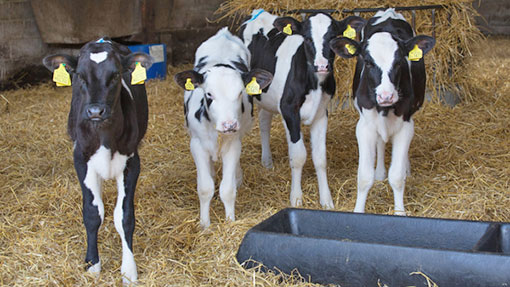6 common youngstock housing mistakes farmers make

As winter approaches, getting youngstock housing right is essential to prevent growth checks and increased risk of respiratory disease.
Farmers preparing calf accommodation in the coming weeks should focus on animal health and productivity to maximise margins.
If calves fail to meet growth targets, rearing times will extend, adding unwelcome feed costs at a time where market prices mean efficiency is key.
Jamie Robertson, honorary research fellow with the School of Biological Science at the University of Aberdeen, says he cannot understand why dairy calves not are not treated as well as dairy cows.
See also: Igloos offer perfect environment for calf rearing
“This is the only production system where the young are not looked after. We know what a calf needs, we can put numbers to these things, but we need to start from day one,” he says.
Mr Robertson talks frankly about common mistakes farmers are making.
1. Temperature – Pay attention to it
“If you don’t, you’re missing a trick; it’s money in your pocket,” says Mr Robertson.
- A calf’s lower critical temperature (LCT) refers to the temperature below which the calf will need to burn energy to keep warm. Keeping the calf above its LCT means nearly all the energy goes into growth.
- In the UK, between October and April, the calf will fall below its critical temperature.
- LCT varies depending on calf size, bedding dampness and air speed.
- For example, a 100kg large-breed heifer growing at 0.5kg/day (liveweight) will have a LCT of 10C if windspeed is 0.5m/sec (1mph). This calf will cope with the UK winter temperatures.
- If the calf is exposed to drafts (2m/sec or nearly 5mph), it will start burning energy to keep warm if the environmental temperature falls below 19C.
- Damp bedding also causes the calf’s LCT to rise to 16C. However, if the calf is on damp bedding and in a draft, the LCT increases to 25C.
- As UK ambient temperature is usually below 25C for most of the year, the calf in these conditions will constantly be burning energy to keep warm.
- The longer the calf is under stress, the worse the physiological impact, which suppresses the immune system.
2. Housing – Designs won’t cost the earth but need to be intelligent
“If hygiene is the most important thing for a young animal, why do we put calves into buildings that aren’t cleanable?” asks Mr Robertson.
- Buildings with cracks in the walls will harbour campylobacter. Calf pens must be made from materials that are easy to clean thoroughly.
- Jet washing pens in or near the calf building will spread pathogens in the aerosols created and increase moisture levels in the environment.
- Calves also need a good water supply that is clean and readily accessible.
- Housing requires proper drainage with a 1:20 slope, particularly where automatic calf feeders are in use.
3. Moisture – Avoid the big chill or lose money, drier is better
“You won’t beat calf pneumonia until you get better control of moisture. It’s not difficult – bugs like moisture,” says Mr Robertson.
- Calves in cold, ambient temperatures will feel colder if the environment is also damp.
- To evaporate moisture into the atmosphere takes energy and this usually comes from the animals at a rate of 3.4 hours of calf heat a kg of water.
- Moisture in the air is not ideal either, investment in drainage so the housing environment remains dry is vital to calf health.
4. Ventilation – Vital to minimise disease spread
“A building must ventilate even when the wind isn’t blowing,” says Mr Robertson.
- Ventilation removes accumulated rubbish and is very good at killing pathogens.
- After an hour in calf housing with 100% fresh air moving through it, 90% of the bugs inside will be killed.
- This falls to about 40% of bugs killed when fresh airflow is halved.
5. What stack effect?
“The calf house is the coldest as they produce the least heat. I am highly critical of high-volume buildings, put them in a small, well-ventilated box,” says Mr Robertson.
- The temperature will be the same inside as outside, so there will be no hot air to rise and no stack effect.
- Houses with open ends and lower roof levels with solid walls are more likely to produce a stack effect.
- Don’t cram them in to keep them warm. An area of 0.4sq m a calf is recommended.
- High stocking densities are a risk to health, performance and profits.
6. Energy conservation or addition – know your climate and their needs
“There are 10,000 calf jackets out there, I’m confident there’ll be another 20,000 this winter. It’s a little thing, but it helps conserve energy,” said Mr Robertson.
- Research showed black-and-white calves already growing well in Aberdeen without calf jackets increased their daily liveweight gain by 100g/day to 1,050g from birth to seven days old when wearing jackets.
- Adding heat lamps is worthless unless the building is insulated.
- When using heat lamps, set every thermostat to the calves LCT so they only come on when the calves get cold.
“Let’s be precise, get the knowledge, know you’re environment and be like everyone else,” he concluded.
